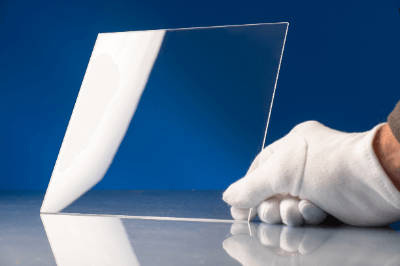What Is a Glass Substrate?

Glass Substrate is a general term for flat glass substrates that have been given functions specific to their intended use.
There are various types of glass depending on the alkali content and sheet thickness, and their smoothness and electrical properties differ from those of ordinary sheet glass. The applications range from computer monitors and smartphone displays to solar cells.
There is also a type of Glass Substrate called Glass Epoxy Substrate, which is made by impregnating woven glass fibers with epoxy resin and molding them. Glass epoxy substrates can be manufactured at low cost. Electronic components are mounted on the substrate to form electronic circuits for operating electronic devices. They are also commonly referred to as printed circuit boards.
Uses of Glass Substrate
Glass Substrate is used in a variety of applications ranging from consumer to industrial equipment. Specific applications are as follows:
1. Display and Cover Glass Applications
Glass Substrate is used in mobile devices such as smartphones and tablets that we use in our daily lives, as well as in displays for car navigation systems. They are typically as thin as 0.5 to 1.1 mm and require high levels of transparency and smoothness.
When used for LCD TV displays, it is important to keep the alkali content down to 0.1% in order to prevent contamination of the LCD material and its effect on transistor characteristics if it contains alkali components.
There are also applications for cover glass for touch panels and image sensors, for which Glass Substrate that has been chemically treated to make it about five times stronger than normal glass is used.
2. Electrical and Electronic Equipment Applications
Glass epoxy substrates are used in motherboards inside PCs and digital cameras. Glass epoxy substrates are the most commonly used printed circuit boards and support the stable operation of electrical and electronic equipment.
Principle of Glass Substrate
Unlike ordinary glass, Glass Substrate for displays requires extremely high performance. In order to accurately display the highly vivid images and video displayed on LCDs and OLEDs, the surface is processed to be as smooth as possible with minimal surface irregularities.
The standards are also so strict that any foreign matter that may get mixed in is rendered invisible. As displays become larger and lighter, demand for Glass Substrate that is both thin and rigid is increasing.
Glass Substrate is a material made by impregnating glass fiber with epoxy resin and curing it. Therefore, it has the advantage of having minimal dimensional change even if the ambient temperature changes. Another advantage is that the material itself is hard and has excellent heat resistance, moisture absorption, and electrical characteristics.
The cost of production is relatively low, and materials of various copper foil thicknesses are available, making it highly versatile. It is easy to make double-sided and multilayered substrates, and are widely used in electronic devices. On the other hand, it has the disadvantage of requiring specialized equipment for manufacturing.
Types of Glass Substrate
Glass is an inorganic mixture of silica sand, soda, and alumina. Various types of Glass Substrates can be produced depending on the content ratio of the constituent materials. The characteristics of various types of Glass Substrate are as follows:
1. Alkali-Free Glass
This type of glass contains only 0.1% alkali oxide and is mainly used for liquid crystal display applications. Thin-walled glass substrates with a thickness of 0.3 mm have been manufactured. It has excellent smoothness and heat resistance.
2. Chemically Strengthened Glass
This glass is chemically strengthened and is approximately five times stronger than ordinary Glass Substrate. It is also used for touch panels, glass for optical disks, and cover glass for image sensors.
3. Glass Epoxy Substrates
Traditionally, low-cost paper phenol and paper epoxy substrates have been widely used in consumer electronics, but in recent years, glass epoxy substrates have become the most widely used of all printed circuit boards. Glass epoxy substrates account for most of the single-sided, double-sided, and multilayered substrates.
4. Teflon Substrate
Glass Substrate is a printed circuit board manufactured by impregnating a glass cloth with polytetrahydrofuran (PTFE) resin. Fluororesin has a low relative permittivity and therefore has excellent high-frequency characteristics.